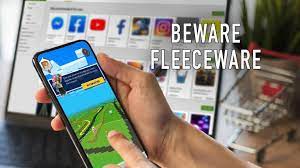Have you ever tried to install a free application for you iPhone or Android only to be confronted with endless ads or a lack of options unless you sign up for an annual subscription? You may have been through fleeceware.
Fleeceware applications lure users to pay an annual fee to have access to the app’s features, despite the fact that the “features” are not essential and are available at no cost in other applications. With free trials and fake reviews, the developers of fleeceware make users pay subscriptions that could cost $9 per week, or the equivalent of $240 per month.
The apps that are of low quality overcharge users for basic functionality, and developers make money even after users have deleted these applications. They are available at both the Apple App Store and Google Play Store Apps that use fleeceware could cost you a significant amount of money you’ve spent.
Looking for the definition of fleeceware or how to eliminate it? We’ve got the answer below.
- Ransomware attack explained what are the symptoms and ways do you stop it
- Adware defined What is it, and what can you do to get rid of it
What’s fleeceware?
Fleeceware is a mobile application that charges users more for features and functions that are basic. Available at the Apple iOS App Store and Google Play Store, the applications vary from photo editors and QR code scanners, and are available for download for free. They don’t include malicious code such as adware and ransomware, but they do contain malicious intent.
Fleeceware app developers typically restrict their apps’ content with unwelcome ads, limited functionality, or trial durations. They send out notifications to users to purchase a subscription in order to provide users with full access to their features of the app. But, these functions are usually minimal and can be found on a free basis in various applications.
The company that provides security Sophos the app fleeceware makes use of users who do not realize they’re still paying for the application’s subscription. Even if a user decides to delete the app, they’ll continue to be paid for the service until they notify the creator they would like to cancel their subscription.
Through promotions through social media platforms the fleeceware app developers lure uninitiated users to visit the listing page of the app. On the page, users will be greeted with glowing five-star reviews, and more than 100 million installs. They are fake and created by a fraudulent method, thereby gaining the user to believe and install the app and also boosting its ranking in the search results of its app store.
These harmful apps are ones that you should not download, so ensure you are aware of how to get rid of them.
Is the fleeceware malware?
Fleeceware could be interpreted as a malware type but it’s actually not. The software is designed with malicious motives ( malicious soft software) however they do not contain code that can interfere with, harm or gain an unauthorised access to a device. They’re just used to make as much money from users by charging a large amount for features and tools which are available in other applications for no cost.
Since it’s not malware the developers of fleeceware apps are able to make their way through Apple and Google’s rigorous security standards for app platforms, since the apps don’t alter a device’s software or attempt to access personal information. However, this does not mean that they’re not scamming users.
What are Apple as well as Google doing regarding it?
Even though Apple as well as Google having strict rules to prevent fraudulent apps and scams generally, the fleeceware applications are accepted because they don’t have access to private information or employ malware to bypass security or cause harm to the device.
Fleeceware applications also help store owners as Apple and Google receive a share of sales. According to Sophos says, “In the case of Apple this is 30% the initial year and 15% after onwards in the next year. Therefore that there’s no motivation for Apple as well as Google to get rid of them, even though they have no functionality, and misuse of store’s review systems in order to increase their popularity.”
But, Apple and Google are making steps to remove known fleeceware from their app stores including these fake ChatGPT apps that use fleeceware to defraud users. In April 2020 Google has introduced new rules for app developers to reduce the number of fleeceware applications available that are available on the Play Store and Apple has reaffirmed its policies to eliminate the apps.
Its App Store team might have secured the users against 1.7 million potentially harmful apps however some do slip through the gaps. These include fleeceware apps and there are numerous duplicates. This is why it’s a good idea to be aware of what to do in the event of encountering one.
Do you get rid of the fleeceware?
Fleeceware depends on users to uninstall the application and then forget the fact that they’re a subscriber to this service. In this regard, getting rid of fleeceware is easy for you be able to unsubscribe to the app with the app on your iPhone or Android device.
Unsubscribe from iPhone
1. On your iPhone start your iPhone’s settings app.
2. At the top the screen, tap the top of your initials.
3. Select Subscriptions.
Select the subscription that is linked to application you would like to stop receiving.
5. Tap Cancel Subscription.
How do I unsubscribe from Android
1. On your Android launch Play Store. Store app. Store application.
2. At the top you will see a tap on your photo profile.
3. Select Payments and Subscriptions.
4. Tap Subscriptions.
5. Choose the subscription that is linked to fleeceware app that you would like not to be a part of.
6. Tap Cancel subscription.
Make use of antivirus software to safeguard your device
Fleeceware does not use malicious code, which means security software won’t recognize it as threat. But, even the most reliable antivirus software can detect applications that are out to take you down.
There are numerous free malware removal applications which will remove malware to your device, but it’s important to ensure that these apps are safe, as hackers are also able to disguise these apps in Google Play Store or the Store, App Store as well as the Google Play Store in order to spread further malware.
The top antivirus applications have a variety of security features that eliminate viruses malware, ransomware spyware, or any other malicious software that tries to penetrate your device. Certain antivirus programs like Bitdefender is a good example, offering security packages specifically designed for smartphones such as iPhone or Android and is the most cost-effective choice.
We suggest free applications from reputable cybersecurity firms which include Avast One, AVG and Malwarebytes Mobile Security. They will identify and eliminate malware from your device. Read our opinions on each one below.















